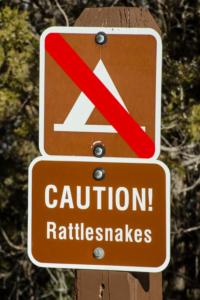
Have you ever gone hiking with an edgy friend who is always on the lookout for snakes on the sides of the trail? When discussing your previous weekend backpacking trip with your co-workers, how many times have you heard, “Aren’t you worried about snakes?”
You should be cautious, but not worried about venomous snakes. Here’s why.
Your Odds of a Snake Bite
It is no surprise that many people fear interaction with snakes when most of the images presented to us about snakes through books, stories, and TV is a negative one. Modern sensationalistic documentaries would lead an uninformed person to believe that king cobras are everywhere, waiting to strike you on the trail.
It is true that a bite from a venomous snake can be lethal to a human if not promptly treated. According to the CDC, between 7,000 and 8,000 people per year are bitten by venomous snakes in the United States and of those, about FIVE result in a fatality. The reality is that you are much more likely to be injured in a car accident getting to and from the trail versus from a snake bite. In 2014, motor vehicle accidents claimed the lives of 32,675 people in the US and inflicted more than 2.34 million individual injuries (source NHTSA). To put this into perspective, it means that you are 6500 times more likely to die in a car accident than from a snake bike and 293 times more likely to be injured in a car crash than to be hurt by a venomous snake. This does not mean that you shouldn’t be cautious when hiking, however.
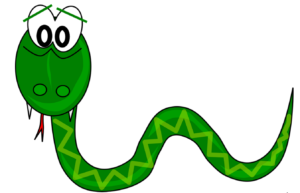
a car crash than from me.
Taxonomy
Venomous snakes are predatory reptiles and are part of the viper family (or viperidae). Except for Antarctica, Greenland, Ireland, Iceland, New Zealand, and Hawaii, they are found all throughout the world. All Vipers have fangs, which are very sharp teeth used for self-defense and to bite and subdue prey. These fangs have small holes in them from which venom is secreted. Venom is a liquid toxin that harms, immobilizes, and in some cases, kills living creatures. It is pretty bad stuff. Other critters that secrete venom include spiders, scorpions, fish, wasps, and jellyfish. Venom usually has to be injected into living tissue for it to cause harm. A viper’s mouth is capable of opening nearly 180 degrees, enabling them to eat prey that is much larger than their body.
Snake Behavior
After a venomous snake bites its prey, it will typically scurry away to avoid retaliation. It will return later to eat the prey after a lengthy search to find it. If you find a small dead animal on the trail with no apparent injuries, it could have succumbed to a recent bite from a venomous snake who will soon be back to get it.
Snakes do not get “mad” in the way that humans do. If a snake is cornered, coiled, puffed out, and hissing at you, it isn’t angry at you. It is merely doing this to try and keep you away. After all, in a snake’s eyes, you are the predator. Snakes coil up to protect their bodies much the same way that humans ball up in the fetal position during an attack. This is a protective posture that helps protect vital organs.
Some species of snakes are less fearful of humans than others. Rattlesnakes and cottonmouth snakes are usually not afraid to stand their ground. But for the most part, snakes are more than happy to avoid you as you come up the trail.
We often don’t think of snakes when we are in the water. If you are kayaking or swimming in a river or lake, keep in mind that venomous snakes, including rattlesnakes, are excellent swimmers and may be present.
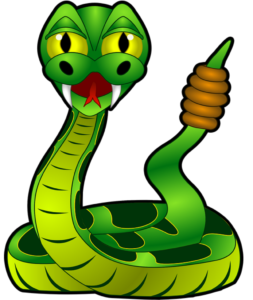
The majority of snakes on Earth are non-venomous. A non-venomous snake can still bite you and inflict injury; it just does not have the venom. A bite from a python will not inject any poison, but it sure will hurt! All snakes are reptiles, which means that they get their energy primarily from the sun. This is why they do not have to eat as often as mammals, birds, or fish. At some point, all reptiles need to bask in the sun to recharge their bodies. This is why you almost never see them in the winter months when the days are short and often cloudy. In those times they are holed up somewhere for weeks or even months at a time, conserving energy. Rocks and open sandy areas are common spots for snakes to soak up the sun. They usually prefer to be in places where they can quickly retreat from predators. This is why the middle of a hiking trail can be a preferred spot for recharging, as they can duck into the brush should a predator show up. Most snakes are nocturnal, and the only reason they would come out in the daytime is to absorb sunlight. A snake cannot hear you in the traditional sense. Instead, they can sense vibrations. Most snakes are surprisingly fast and can strike quite a distance away from their resting position. Their strike is nearly instantaneous and is difficult for the human eye to perceive. Most of us just don’t have quick enough reflexes to jump back in time to avoid a striking snake.
How do you Recognize Venomous from Non-Venomous Snakes?
Here in the U.S., we have 4 types of venomous snakes. They are the copperhead, coral snake, cottonmouth, and the rattlesnake. You are very unlikely to see a coral snake; the other three can be common, depending on where you are located.
Copperhead snakes are common in the southeastern US, where they prefer the heat and humidity. They are generally found in shady wooded areas and just as their name suggests, are a copper color with hourglass bands and have elliptical-shaped pupils. Look for the yellow tip on their tail. Copperheads usually are very docile snakes, and unless you accidentally step on or provoke one, it is likely to slither away from you as quickly as it can.
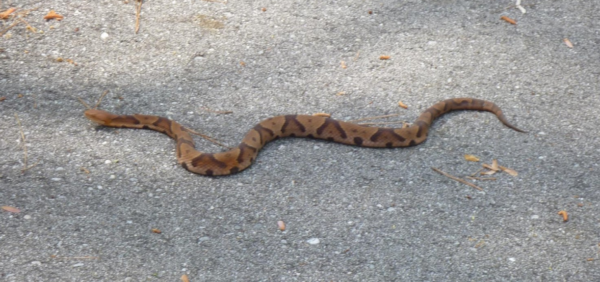
Coral snakes are a very reclusive species of venomous snakes and are found in the southeastern US, as well as southern Arizona. You can identify them by their bright colors: red, black, and yellow. They have the 2nd most toxic venom in the world, however, their fangs are much shorter than most venomous snakes. Encountering a coral snake on the trail is pretty rare.
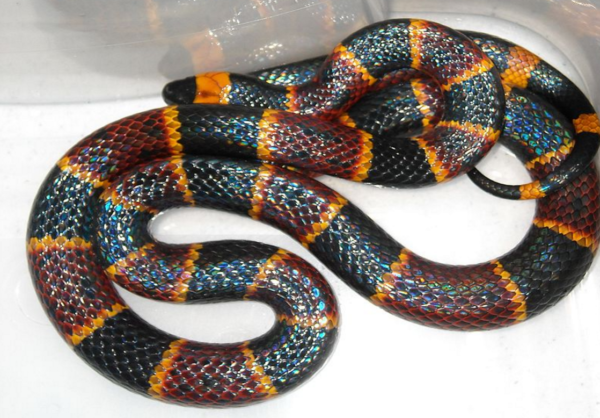
Cottonmouth, commonly referred to as a “water moccasin,” is a pit viper species of snake that is found in the southeastern US. Pit viper means that the snake has heat-sensing pits just above its mouth, which are used to locate prey. The cottonmouth is nearly an all-black snake and has elliptical pupils. Sometimes they have olive or gray undersides. They are known to hiss when cornered and stand their ground. Like most snakes, they are excellent swimmers.
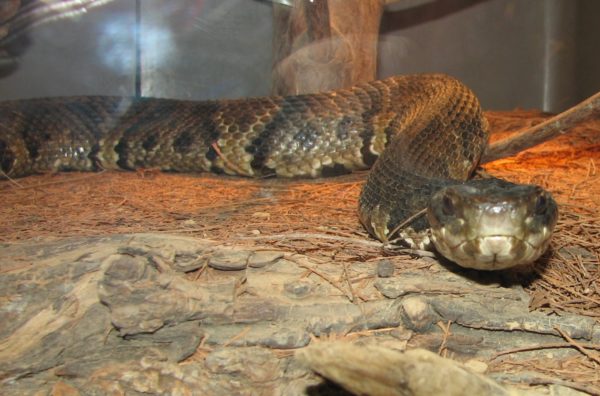
Rattlesnakes are the most common venomous snake in the US, and the majority of venomous snake bites are from them. Rattlesnakes are found in most of the lower 48 states, and there are many different species. As their name suggests, they have a rattle at the end of their tail. Rattlesnakes are easy to identify. If you can only see the head, look for the elliptical pupils and the two heat-sensing pits on their nose. Here in Northern California, the Northern Pacific Rattlesnake is most common. In Southern California, the Green Mojave is common in the desert areas. The Eastern Diamondback is probably the most common species found in the Southeastern US and is the one responsible for most bite-related deaths. The Timber Rattlesnake lives in nearly all states east of the Mississippi River. Rattlesnakes are nighttime predators and usually only appear during the day to soak up the sun.
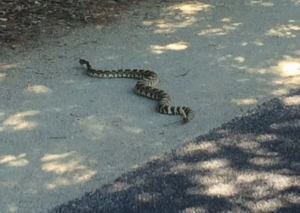
Tips to Avoid Snake Bites
- Be alert. Snake season is generally during the warmer months of the year. Snakes are most active when the weather suits their heat-seeking needs. On hot sunny days, snakes are most likely hiding in a cooler shadier spot. So be extra careful underneath fallen trees and rocks on such days.
- If you encounter a snake, no matter the species, leave it alone and walk away or around it. Unless your job requires you to do it, there is entirely no reason for you to handle a snake.
- Avoid walking through tall grass unless you can clearly see the ground. Do not walk in tall grass at night. If you must walk through tall grass, do so at a much slower pace than usual. Snakes cannot hear you coming but can feel the vibrations from your feet.
- Rattlesnakes are nocturnal. At night, zip up your tent and always check your shoes before you put them on. If you sleep out in the open, it is unlikely that a snake will bother you. If one happens to slither near you while you are sleeping, chances are, the snake will change course to avoid you. Snakes like to hide, so if you leave out a bag or covering overnight, check it for snakes in the morning.
- Always use caution when passing through large, open rocky areas. This is prime rattlesnake habitat. Don’t reach blindly into areas that you can’t see, either.
- Clothing can help prevent snake bites. Wearing thicker or taller shoes can sometimes be effective in protecting your feet, but only extremely thick clothing would stop a snake’s fangs from penetrating. There are also commercial products available to help protect your legs.
- Not all dogs know to retreat from snakes. Don’t let your dog run off leash in areas where venomous snakes are common. Remember, you are your dog’s caretaker, and their chances are much greater of being bitten when you don’t look after them.
- At home, don’t leave your garage door cracked open – especially on hot days! It is common for people to leave their garage door partially open for feline access or for ventilation. Snakes will naturally seek out the cooler and shadier areas during hot days. Leaving a garage door cracked open is usually how snakes end up in people’s garages.

Snake Bite First Aid
If you have been bitten by a snake, puncture marks and bleeding will be visible at the bite location. Nausea, labored breathing, sweating, disturbed vision, and numbness are some of the common symptoms of a venomous snake bite. First and foremost, get help immediately if you are bitten by a poisonous snake. If you are in an isolated area or by yourself, you will have to determine the best course of action to take to accomplish this. Get away from the snake and do not try to capture it. If you can safely do it, take a picture of the snake to help identify the species for medical treatment. Do not try to suck out the poison or use a tourniquet. Keep the wound below the heart and make sure you and the victim remain as calm and immobile as possible. Do not drink caffeine or alcohol. Don’t put ice on the wound or pour water over it. Get to the hospital as soon as possible. Antivenom (or antivenin) usually is what is administered to a snake bite victim at the hospital. Knowing the type of snake is helpful to the doctor since there are many different types of antivenom.
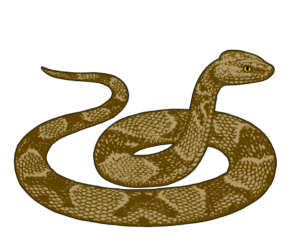
Understanding snakes are the key to avoiding dangerous encounters with them. In researching this article, I found that in many cases, the typical snake bite victim was either handling the snake or taunting it. A fair number of these victims were intoxicated, as well. Snakes are part of our ecosystem, and they have a right to be here. Sometimes they will accidentally stray into our lives, but under most circumstances, they will leave us alone. For more information on snakes and reptiles, I encourage you to watch David Attenborough’s fantastic documentary, Life in Cold Blood.
2 thoughts on “Hiking with Venomous Snakes”
“Except for Australia…” so the brown, king brown, taipan, tigersnake, copperhead and other Aussie snakes aren’t snakes!???
(I think you meant Ireland as being snake free, rather than Aus)
All that having been said, always good to see a piece talking sensibly about snakes. (I’m no Aussie, I’m based in Hong Kong and occasionally come across cobras, ratsnakes, red-necked keelbacks, bamboo pit vipers and others – including seeing king cobras in the wild: 2 in one day, but never before or since!)
Thank you for the correction, Richard. We’ll update the post!